Michael R. Brasher's Blog
September 14, 2020
The American Civil War: A Military Overview made it to the Best American Civil War Books of All Time
 I'm happy to announce that my book, "The American Civil War: A Military Overview", made it to BookAuthority's Best American Civil War Books of All Time:
I'm happy to announce that my book, "The American Civil War: A Military Overview", made it to BookAuthority's Best American Civil War Books of All Time:BookAuthority collects and ranks the best books in the world, and it is a great honor to get this kind of recognition. Thank you for all your support!
The book is available for purchase on Amazon.
Published on September 14, 2020 05:37
April 26, 2020
The Second Mississippi: An Introduction to the Full Annotated Roster (FREE PDF Download) Updated 10-15-21
Deciding I need to write my 2nd Mississippi Regimental History like you would when you start to "eat an elephant...one bite at a time," I am pleased to announce my self-published FREE PDF e-book entitled "The Second Mississippi Infantry Regiment: An Introduction to the Full Annotated Roster." It has some 450 pages and includes information on all the 1,888 members of the 2nd Mississippi (of which I am aware at any rate) as well as some additional statistical introductory material. I hope this to be the first in several volumes on the history of this hard-fighting regiment. 

Published on April 26, 2020 11:35
The Second Mississippi: An Introduction to the Full Annotated Roster (FREE PDF Download)
Deciding I need to write my 2nd Mississippi Regimental History like you would when you start to "eat an elephant...one bite at a time," I am pleased to announce my self-published FREE PDF e-book entitled "The Second Mississippi Infantry Regiment: An Introduction to the Full Annotated Roster." It has some 450 pages and includes information on all the 1,888 members of the 2nd Mississippi (of which I am aware at any rate) as well as some additional statistical introductory material. I hope this to be the first in several volumes on the history of this hard-fighting regiment. 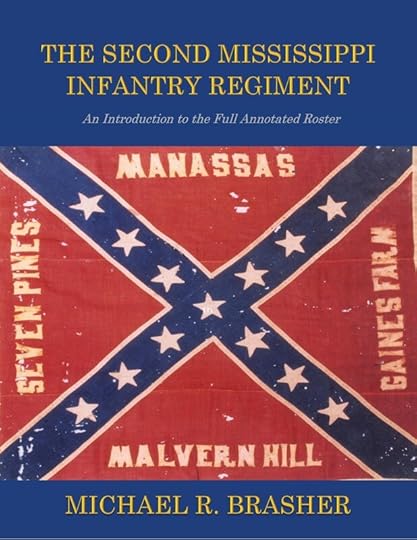

Published on April 26, 2020 11:35
March 8, 2020
The End: Petersburg and Capture at Hatcher’s Run
A Sketch of the History of the Second Mississippi Infantry Regiment: The End: Petersburg and Capture at Hatcher's Run In what would be his final flanking maneuver, Grant brilliantly shifted his army south of the James River and moved on Petersburg. This move caught Lee by surprise and he reacted with caution. He maintained Hill’s Third Corps north of the James until June 18th. By that point in time, he was finally convinced that Petersburg was truly Grant’s objective. During the next six weeks, the 2nd Mississippi, as a part of Davis’ Brigade, crossed the James River five times in response to Federal threats, but did not engage in battle.[1]
Davis’ Brigade was being held in reserve in Petersburg on August 18th, when the Federal V Corps seized the tracks of the Weldon Railroad at Globe Tavern. Heth moved at noon with Davis’ and Henry Walker’s Brigades to throw back the Federal incursion. The brigade had, however, detached about a third of its strength to continue working on Confederate entrenchments.[2]
The Confederates covered the three miles in the intense summer heat and deployed in line of battle on both sides of the railroad. Davis was to the right, or west side, of the tracks. The Confederates, facing south, could only see Union skirmishers stretched across a cornfield. Logic told them that a line of blue infantry awaited them in the woods beyond, but they had no idea that their two under-strength brigades were about to assault an entire Union corps.[3]
Screaming their Rebel yell, the gray line moved to the charge. Although the Federal brigade of Brigadier General Joseph Hays was deployed and ready about 30 yards into the woods, Davis’ Brigade overlapped both flanks of the Federal line and sent them reeling back in disorder. Regrouping, the regiments of the brigade continued their advance and ran into a second Yankee defensive line some 40 yards beyond the first. The Federal brigade of Colonel Nathan Dushane loosed a deadly volley into the gray lines and forced them back about 50 yards. The Union advantage was only temporary however, as the Confederates also managed to flank his position and soon put Dushane’s men to disordered flight. The Federal V Corps commander, Major General Gouvernor Warren, reacted quickly to these initial Southern successes. He rapidly assembled a strong defensive line backed by a heavy concentration of artillery in a clearing on the other side of the woods. When Davis’ men emerged from the woods, they suddenly found themselves facing triple their strength of infantry “stiffened” by several artillery batteries. By 2:30 p.m., the Confederate offensive had played out and the men constructed a line of entrenchments to defend their gains while awaiting reinforcements.[4]
The next day, August 19th, both sides fed more men into the battle around Globe Tavern. Thinking the Federals had weakened their lines to concentrate their main effort in fighting to the east, the 2nd Mississippi and other regiments of Davis’ Brigade were ordered to assault the lines to their front. They carried out the order, but found the Federal entrenchments just as strongly manned as the previous day. The attack was beaten back and the Confederates returned to their own lines. The remainder of the day passed without major activity in Davis’ sector. The following day, Davis’ Brigade was relieved by reinforcements. However, by this time the Federal troops had a firm grip on the railroad and could not be driven off. Thus, Lee lost another vital artery into the Richmond-Petersburg stronghold. Grant had paid a high price for the Weldon line, but was slowly tightening his grip on Lee’s army.[5]
As might be expected, the morale of Lee’s army was deteriorating rapidly with extended duty in the Petersburg trenches. However during an August inspection of the brigade, the Inspector General found “…the arms and accouterments in very bad condition in all the regiments except the Second, Col. J. M. Stone, and Eleventh, Maj. R. O. Reynolds. In the Second they were good; in the Eleventh very good, clean inside and bright outside…”[6] Thus the fighting spirit of the two veteran Mississippi regiments in Davis’ Brigade remained unbroken (although receiving praise, the 2nd never seemed able to outshine its sister regiment in the eyes of the Inspector General’s office).
As a part of Grant’s Fifth Offensive late in September 1864, his army attacked both Confederate flanks along the Petersburg-Richmond line. On the Federal left, the V and IX Corps tested the gray defenses. Heth’s Division, positioned in reserve near the center of the Petersburg defenses, rushed to counterattack the Federal incursion. Heth was able to blunt the Union assault on September 29th before Davis arrived to help. On the following day, Heth planned an attack against what he believed was a Federal V Corps’ flank that was “in the air.” As the situation developed however, the general quickly discovered that he had been mistaken.[7]
In a punishing rainstorm, the division deployed on either side of Squirrel Level Road, facing south. Instead of a coordinated attack, Heth fed his units into action piecemeal against Warren’s Federals. In contrast to the open flank he expected to find, Heth discovered to his dismay that the Union line had been bent back on the right so that it now faced north, squarely across the path of the attacking Confederates. The strongly entrenched Federals sent the Confederates streaming back in utter disorder.[8]
The Petersburg front remained fairly stable until October 27th, when the 2nd Mississippi fought its last battle of 1864. Hancock’s and Warren’s corps, under orders from Grant, moved to circle the left of the Confederate line and interdict the Boydton Plank Road. In a repeat of previous such moves, elements of A. P. Hill’s Third Corps intercepted the Federals at Burgess’ Mill and drove them back.[9]
For the next five months, the 2nd Mississippi settled into the “routine” of trench warfare. Many aspects of their life in the trenches would become familiar to their grandchildren in France more than fifty years later. Few casualties were suffered, but constant diligence was required because enemy sharpshooters and artillery shells, especially the high-trajectory mortars, were an ever-present threat.
By early 1865, the 2nd Mississippi was reported to be under the command of Lieutenant Colonel John Blair, who had been promoted and exchanged following his capture in the Railroad Cut at Gettysburg. However, Blair would once more be taken prisoner at Hatcher’s Run during the fighting on February 5-7, 1865. Colonel Stone was dispatched with a detail of several men on January 8, 1865 to return to Mississippi. He was to recruit and try and round up absentees in an attempt to rebuild the brigade’s depleted numbers. Several companies of the regiment were consolidated at this time because they had been so severely reduced. The 2nd Mississippi probably mustered fewer than 150 effectives at this point in time. Command of the regiment was placed in the hands of the one captain still present with the regiment, William F. Harvey of Company K.[10]
On March 25, 1865, Lee decided to gamble on an attack against Fort Stedman to try and break Grant’s stranglehold on Petersburg. Major General John B. Gordon was to lead the attack. As a diversion, elements of Davis’ Brigade demonstrated against the Federals at Hawks’ Farm. Gordon captured the fort, but could not hold it against the overwhelming Federal counterattacks. Less than a week later, Grant’s army launched an all-out series of attacks that were intended to break Lee’s thin lines at Petersburg and finally end the siege. On April 1st, Federal cavalry and infantry moved well around the Confederate right flank and launched an attack on Pickett’s section of the line at Five Forks. The gray line crumbled, and Grant secured a hold on the Southside Railroad. Richmond was now untenable.
The following day, the Federal army initiated attacks all along Lee’s Petersburg lines, penetrating in many areas and causing the Southern defenses to disintegrate. In the area where Heth’s Division was positioned, east and northeast of Burgess’ Mill, the Union VI and II Corps pushed through the gray defenders and began to roll up the line from their right to left, driving west. The 2nd Mississippi was in position near the southern end of the line at Hatcher’s Run, which was swollen from recent rains and impassable to infantry. When the Federals broke through to the regiment’s left, the 2nd Mississippi was trapped with Federal troops converging on three sides and the raging stream to their rear. Pressed back to the bank of Hatcher’s Run, most of the regiment would be taken prisoner, but a few desperate individuals may have made it across the rushing water to freedom only to be surrendered a week later at Appomattox Court House.[11]
For the ninety-nine[12] proud veterans of the 2nd Mississippi trapped on the east bank of Hatcher’s Run, captivity was only minutes away. The men had one final task to accomplish on behalf of their regiment, however. They were determined that the colors of the 2nd Mississippi Infantry Volunteers would never again become a Yankee trophy. Private Nathaniel M. Bynum tore the flag from its staff and hid it inside his jacket. He would keep it securely hidden while a prisoner of war until paroled and released from Ft. Delaware.[13]
And so, as the last ragged Rebel soldier was led away from the rushing waters of Hatcher’s Run and into captivity, the 2nd Mississippi Infantry Regiment, one of the hardest fighting units in the Confederacy’s Army of Northern Virginia, passed into Civil War history.
[1] O.R., 40, pt. 2, pp. 662-663.
[2] O.R., 42, pt. 1, pp. 428-429.
[3] Ibid., p. 455.
[4] Ibid., pp. 474, 480-481.
[5] Ibid., p. 504.
[6] O.R., 42, pt. 2, p. 1273.
[7] Shelby Foote, The Civil War: A Narrative, vol. 3 (New York, 1974), p. 561.
[8] Ibid.
[9] Ibid., p. 573-574.
[10] Sibley, The Confederate Order of Battle, Volume 1, pp. 174, 184, 193, 212. Stone never made it back to his regiment. He was with a group of several hundred men on their way back to their units at Petersburg, when Stoneman’s cavalry raided Salisbury, NC in mid-April 1865. Stone, combative to the end, agreed to help lead a defense of the town with these men and the local defense troops. However, outnumbered and outflanked by Stoneman’s rapidly moving forces, most of the defenders were taken prisoner. Stone was sent to Johnson’s Island where he was paroled on June 25, 1865. He was elected Mayor of Iuka later that same year.
[11] Jubal A. Early and others, eds. Southern Historical Society Papers, vol. 15 (Richmond). pp. 284-285. CMSR. In addition to the 99 members of the regiment captured at Hatcher’s Run on April 2, 1865, one officer – the surgeon, James J. Holt, the Quartermaster Sergeant, J. M. Cayce, and 18 privates were listed on the April 9, 1865 Appomattox parole rosters for the 2nd Mississippi. Most of these men were probably on detailed or detached status from the regiment at the time. Few, if any, from the group captured at Hatcher’s Run escaped.
[12] CMSR.
[13] Letter, Bynum to Rowland, August 1, 1916, Mississippi Department of Archives and History, Acc. No. 68.42. In 1916, George Washington Bynum of Corinth, Mississippi, who, along with N. M. and four other brothers, were members of Company A, sent the tattered battleflag to the Mississippi State archives in Jackson. He wrote the following letter to the archives director, Dunbar Rowland:
You have one flag of the 2d Miss. in your keeping which was captured in the famous railroad cut at Gettysburg July 1, 1863 and returned by the Government some years since; this one I send you was supplied by the QuarterMaster’s Department on July 2 [1863], and was courageously borne through shot and shell to the ramparts of Little Round Gap, Gettysburg on July 3, 1863 and on the retirement of Gen. Lee from Pennsylvania through all the bloody battles of Virginia until the Surrender of the Regiment April 2, 1865 at Hatcher’s Run, where my brother, N. M. Bynum tore it from the flag staff, concealed it beneath his little gray jacket and carried it through prison at Ft. Delaware. W. H. Byrus [he actually means W. H. Byrn], the color bearer, brought it home from prison.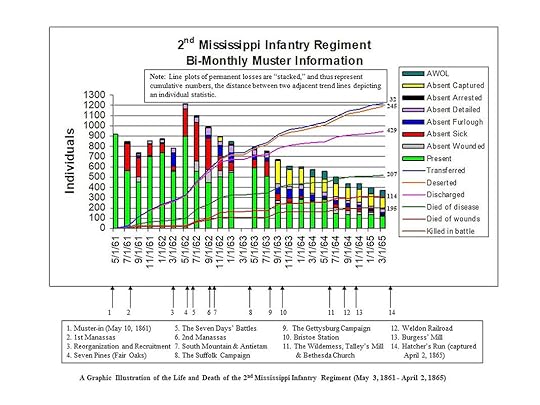
Davis’ Brigade was being held in reserve in Petersburg on August 18th, when the Federal V Corps seized the tracks of the Weldon Railroad at Globe Tavern. Heth moved at noon with Davis’ and Henry Walker’s Brigades to throw back the Federal incursion. The brigade had, however, detached about a third of its strength to continue working on Confederate entrenchments.[2]
The Confederates covered the three miles in the intense summer heat and deployed in line of battle on both sides of the railroad. Davis was to the right, or west side, of the tracks. The Confederates, facing south, could only see Union skirmishers stretched across a cornfield. Logic told them that a line of blue infantry awaited them in the woods beyond, but they had no idea that their two under-strength brigades were about to assault an entire Union corps.[3]
Screaming their Rebel yell, the gray line moved to the charge. Although the Federal brigade of Brigadier General Joseph Hays was deployed and ready about 30 yards into the woods, Davis’ Brigade overlapped both flanks of the Federal line and sent them reeling back in disorder. Regrouping, the regiments of the brigade continued their advance and ran into a second Yankee defensive line some 40 yards beyond the first. The Federal brigade of Colonel Nathan Dushane loosed a deadly volley into the gray lines and forced them back about 50 yards. The Union advantage was only temporary however, as the Confederates also managed to flank his position and soon put Dushane’s men to disordered flight. The Federal V Corps commander, Major General Gouvernor Warren, reacted quickly to these initial Southern successes. He rapidly assembled a strong defensive line backed by a heavy concentration of artillery in a clearing on the other side of the woods. When Davis’ men emerged from the woods, they suddenly found themselves facing triple their strength of infantry “stiffened” by several artillery batteries. By 2:30 p.m., the Confederate offensive had played out and the men constructed a line of entrenchments to defend their gains while awaiting reinforcements.[4]
The next day, August 19th, both sides fed more men into the battle around Globe Tavern. Thinking the Federals had weakened their lines to concentrate their main effort in fighting to the east, the 2nd Mississippi and other regiments of Davis’ Brigade were ordered to assault the lines to their front. They carried out the order, but found the Federal entrenchments just as strongly manned as the previous day. The attack was beaten back and the Confederates returned to their own lines. The remainder of the day passed without major activity in Davis’ sector. The following day, Davis’ Brigade was relieved by reinforcements. However, by this time the Federal troops had a firm grip on the railroad and could not be driven off. Thus, Lee lost another vital artery into the Richmond-Petersburg stronghold. Grant had paid a high price for the Weldon line, but was slowly tightening his grip on Lee’s army.[5]
As might be expected, the morale of Lee’s army was deteriorating rapidly with extended duty in the Petersburg trenches. However during an August inspection of the brigade, the Inspector General found “…the arms and accouterments in very bad condition in all the regiments except the Second, Col. J. M. Stone, and Eleventh, Maj. R. O. Reynolds. In the Second they were good; in the Eleventh very good, clean inside and bright outside…”[6] Thus the fighting spirit of the two veteran Mississippi regiments in Davis’ Brigade remained unbroken (although receiving praise, the 2nd never seemed able to outshine its sister regiment in the eyes of the Inspector General’s office).
As a part of Grant’s Fifth Offensive late in September 1864, his army attacked both Confederate flanks along the Petersburg-Richmond line. On the Federal left, the V and IX Corps tested the gray defenses. Heth’s Division, positioned in reserve near the center of the Petersburg defenses, rushed to counterattack the Federal incursion. Heth was able to blunt the Union assault on September 29th before Davis arrived to help. On the following day, Heth planned an attack against what he believed was a Federal V Corps’ flank that was “in the air.” As the situation developed however, the general quickly discovered that he had been mistaken.[7]
In a punishing rainstorm, the division deployed on either side of Squirrel Level Road, facing south. Instead of a coordinated attack, Heth fed his units into action piecemeal against Warren’s Federals. In contrast to the open flank he expected to find, Heth discovered to his dismay that the Union line had been bent back on the right so that it now faced north, squarely across the path of the attacking Confederates. The strongly entrenched Federals sent the Confederates streaming back in utter disorder.[8]
The Petersburg front remained fairly stable until October 27th, when the 2nd Mississippi fought its last battle of 1864. Hancock’s and Warren’s corps, under orders from Grant, moved to circle the left of the Confederate line and interdict the Boydton Plank Road. In a repeat of previous such moves, elements of A. P. Hill’s Third Corps intercepted the Federals at Burgess’ Mill and drove them back.[9]
For the next five months, the 2nd Mississippi settled into the “routine” of trench warfare. Many aspects of their life in the trenches would become familiar to their grandchildren in France more than fifty years later. Few casualties were suffered, but constant diligence was required because enemy sharpshooters and artillery shells, especially the high-trajectory mortars, were an ever-present threat.
By early 1865, the 2nd Mississippi was reported to be under the command of Lieutenant Colonel John Blair, who had been promoted and exchanged following his capture in the Railroad Cut at Gettysburg. However, Blair would once more be taken prisoner at Hatcher’s Run during the fighting on February 5-7, 1865. Colonel Stone was dispatched with a detail of several men on January 8, 1865 to return to Mississippi. He was to recruit and try and round up absentees in an attempt to rebuild the brigade’s depleted numbers. Several companies of the regiment were consolidated at this time because they had been so severely reduced. The 2nd Mississippi probably mustered fewer than 150 effectives at this point in time. Command of the regiment was placed in the hands of the one captain still present with the regiment, William F. Harvey of Company K.[10]
On March 25, 1865, Lee decided to gamble on an attack against Fort Stedman to try and break Grant’s stranglehold on Petersburg. Major General John B. Gordon was to lead the attack. As a diversion, elements of Davis’ Brigade demonstrated against the Federals at Hawks’ Farm. Gordon captured the fort, but could not hold it against the overwhelming Federal counterattacks. Less than a week later, Grant’s army launched an all-out series of attacks that were intended to break Lee’s thin lines at Petersburg and finally end the siege. On April 1st, Federal cavalry and infantry moved well around the Confederate right flank and launched an attack on Pickett’s section of the line at Five Forks. The gray line crumbled, and Grant secured a hold on the Southside Railroad. Richmond was now untenable.
The following day, the Federal army initiated attacks all along Lee’s Petersburg lines, penetrating in many areas and causing the Southern defenses to disintegrate. In the area where Heth’s Division was positioned, east and northeast of Burgess’ Mill, the Union VI and II Corps pushed through the gray defenders and began to roll up the line from their right to left, driving west. The 2nd Mississippi was in position near the southern end of the line at Hatcher’s Run, which was swollen from recent rains and impassable to infantry. When the Federals broke through to the regiment’s left, the 2nd Mississippi was trapped with Federal troops converging on three sides and the raging stream to their rear. Pressed back to the bank of Hatcher’s Run, most of the regiment would be taken prisoner, but a few desperate individuals may have made it across the rushing water to freedom only to be surrendered a week later at Appomattox Court House.[11]
For the ninety-nine[12] proud veterans of the 2nd Mississippi trapped on the east bank of Hatcher’s Run, captivity was only minutes away. The men had one final task to accomplish on behalf of their regiment, however. They were determined that the colors of the 2nd Mississippi Infantry Volunteers would never again become a Yankee trophy. Private Nathaniel M. Bynum tore the flag from its staff and hid it inside his jacket. He would keep it securely hidden while a prisoner of war until paroled and released from Ft. Delaware.[13]
And so, as the last ragged Rebel soldier was led away from the rushing waters of Hatcher’s Run and into captivity, the 2nd Mississippi Infantry Regiment, one of the hardest fighting units in the Confederacy’s Army of Northern Virginia, passed into Civil War history.
[1] O.R., 40, pt. 2, pp. 662-663.
[2] O.R., 42, pt. 1, pp. 428-429.
[3] Ibid., p. 455.
[4] Ibid., pp. 474, 480-481.
[5] Ibid., p. 504.
[6] O.R., 42, pt. 2, p. 1273.
[7] Shelby Foote, The Civil War: A Narrative, vol. 3 (New York, 1974), p. 561.
[8] Ibid.
[9] Ibid., p. 573-574.
[10] Sibley, The Confederate Order of Battle, Volume 1, pp. 174, 184, 193, 212. Stone never made it back to his regiment. He was with a group of several hundred men on their way back to their units at Petersburg, when Stoneman’s cavalry raided Salisbury, NC in mid-April 1865. Stone, combative to the end, agreed to help lead a defense of the town with these men and the local defense troops. However, outnumbered and outflanked by Stoneman’s rapidly moving forces, most of the defenders were taken prisoner. Stone was sent to Johnson’s Island where he was paroled on June 25, 1865. He was elected Mayor of Iuka later that same year.
[11] Jubal A. Early and others, eds. Southern Historical Society Papers, vol. 15 (Richmond). pp. 284-285. CMSR. In addition to the 99 members of the regiment captured at Hatcher’s Run on April 2, 1865, one officer – the surgeon, James J. Holt, the Quartermaster Sergeant, J. M. Cayce, and 18 privates were listed on the April 9, 1865 Appomattox parole rosters for the 2nd Mississippi. Most of these men were probably on detailed or detached status from the regiment at the time. Few, if any, from the group captured at Hatcher’s Run escaped.
[12] CMSR.
[13] Letter, Bynum to Rowland, August 1, 1916, Mississippi Department of Archives and History, Acc. No. 68.42. In 1916, George Washington Bynum of Corinth, Mississippi, who, along with N. M. and four other brothers, were members of Company A, sent the tattered battleflag to the Mississippi State archives in Jackson. He wrote the following letter to the archives director, Dunbar Rowland:
You have one flag of the 2d Miss. in your keeping which was captured in the famous railroad cut at Gettysburg July 1, 1863 and returned by the Government some years since; this one I send you was supplied by the QuarterMaster’s Department on July 2 [1863], and was courageously borne through shot and shell to the ramparts of Little Round Gap, Gettysburg on July 3, 1863 and on the retirement of Gen. Lee from Pennsylvania through all the bloody battles of Virginia until the Surrender of the Regiment April 2, 1865 at Hatcher’s Run, where my brother, N. M. Bynum tore it from the flag staff, concealed it beneath his little gray jacket and carried it through prison at Ft. Delaware. W. H. Byrus [he actually means W. H. Byrn], the color bearer, brought it home from prison.

Published on March 08, 2020 12:44
February 15, 2020
Spottsylvania and Cold Harbor
A Sketch of the History of the Second Mississippi Infantry Regiment: Spotsylvania and Cold Harbor Unfortunately for Lee, Grant’s reverses in the Wilderness fighting did not result in a Federal withdrawal back North to refit and regroup as had been the case with other Union commanders. Instead Grant once more attempted to pass the Army of the Potomac around Lee’s right flank. Lee again countered by shifting his forces to Spotsylvania Court House and beat Grant to his objective. The new Confederate line rested its left on the Po River near the Block House Bridge and faced northwest, while the right flank curved around to the south beyond the Fredericksburg Road and faced generally east. The 2nd Mississippi occupied a position with Heth’s Division in reserve behind the far-right flank.[1]
Grant, on the morning of May 10th, sent Hancock’s II Corps across the Po River in an attempt to turn the Confederate left flank. This venture would appear to have offered little chance for success however, for the Po turned south beyond the Confederate flank and would have to be crossed a second time by the Federals in order to reach the Confederate rear. When Hancock found that the closest bridge across the Po that led to the rear of the Southern lines was well guarded, he dispersed his troops in search of another crossing place.[2]
Lee dispatched Major General Jubal Early, temporarily commanding the Third Corps, to engage the Federals probing his left flank. Early put together a combined arms task force consisting of Heth’s Division reinforced by additional cavalry and artillery. From the right of the Confederate line they marched entirely across the rear of the Army of Northern Virginia and crossed the Po River well south of the area recently occupied by the Federal II Corps. Heth deployed his division in a line facing north with Davis’ Brigade on the left.[3]
Although Grant had ordered Hancock to bring his men back across the Po, Brigadier General Francis C. Barlow’s Division was still south of the river at 2:00 p.m. when it was struck by Early’s troops. The 2nd Mississippi supported several assaults against Barlow in the area of Talley’s Mill. These attacks were unsuccessful until the Confederates were able to infiltrate troops around the Federal flank and rear. The Federals then fell back across the river with the Confederates in pursuit. The action came to a halt when the Southerners came within artillery range of the Union guns across the river.[4]
Mission accomplished, Early returned to the right end of the Confederate line on the afternoon of May 10th. On May 12th, the day of the Federal assault on the “Bloody Angle,” Davis’ and Walker’s Brigades of Heth’s Division were unsuccessfully attacked by the Federals, probably by Major General Thomas L. Crittenden’s division of Burnside’s IX Corps.[5]
With Grant’s army continually trying to move around the Confederate right, the next fighting occurred along the North Anna River from May 23rd to May 26th. Davis’ Brigade, near the left end of the Confederate line, saw little action at this time. Another move by Grant around the Confederate right brought the two armies to a new set of lines that overlapped those of the old Gaines’ Mill battlefield of 1862. Here Grant foolishly ordered a series of assaults that were bloodily repulsed by Lee’s entrenched Confederates at Cold Harbor on June 3rd. Again, the 2nd Mississippi, stationed with Heth’s Division at the far left of the Confederate lines near Bethesda Church, was not involved in the heaviest fighting although it did suffer some additional losses. For the combined losses of the Wilderness, Spotsylvania and Cold Harbor, the 2nd Mississippi reported 24 killed and 107 wounded. Its strength at the beginning of The Wilderness is unknown, but based on statistical estimates using a portion of the bimonthly muster roll data, the regiment probably had about 280 effectives in its ranks.[6]
[1] O.R., 36, pt. 1, pp. 63-64; William D. Matter, If It Takes All Summer: The Battle of Spotsylvania (Chapel Hill, 1988), p. 129, 132-133; Supplement, 6, pt. 1. p. 706.
[2] O.R., 36, pt. 1, p. 65; Matter, Spotsylvania, pp. 131-135.
[3] O.R., 36, pt. 1, p. 1029; Matter, Spotsylvania, p. 134. Gordon C. Rhea, The Battles for Spotsylvania Court House and the Road to Yellow Tavern, May 7-12, 1864 (Baton Rouge, 1997), p. 136. The exact disposition and composition of Early’s command on May 10th is unknown. It is assumed that Davis is again in personal command of his brigade since he reported back for duty on May 6th and took command of elements of his brigade that had become separated from Colonel Stone at that time.
[4] O.R., 36, pt. 1, pp. 191, 357; Matter, Spotsylvania, pp. 141-148; Rhea, Spotsylvania Court House, p. 140.
[5] Supplement, 6, pt. 1, p. 707; Matter, Spotsylvania, pp. 235-237; Rhea, Spotsylvania Court House, p. 299.
[6] Supplement, 6, pt. 1, p. 708. CMSR.
Grant, on the morning of May 10th, sent Hancock’s II Corps across the Po River in an attempt to turn the Confederate left flank. This venture would appear to have offered little chance for success however, for the Po turned south beyond the Confederate flank and would have to be crossed a second time by the Federals in order to reach the Confederate rear. When Hancock found that the closest bridge across the Po that led to the rear of the Southern lines was well guarded, he dispersed his troops in search of another crossing place.[2]
Lee dispatched Major General Jubal Early, temporarily commanding the Third Corps, to engage the Federals probing his left flank. Early put together a combined arms task force consisting of Heth’s Division reinforced by additional cavalry and artillery. From the right of the Confederate line they marched entirely across the rear of the Army of Northern Virginia and crossed the Po River well south of the area recently occupied by the Federal II Corps. Heth deployed his division in a line facing north with Davis’ Brigade on the left.[3]
Although Grant had ordered Hancock to bring his men back across the Po, Brigadier General Francis C. Barlow’s Division was still south of the river at 2:00 p.m. when it was struck by Early’s troops. The 2nd Mississippi supported several assaults against Barlow in the area of Talley’s Mill. These attacks were unsuccessful until the Confederates were able to infiltrate troops around the Federal flank and rear. The Federals then fell back across the river with the Confederates in pursuit. The action came to a halt when the Southerners came within artillery range of the Union guns across the river.[4]
Mission accomplished, Early returned to the right end of the Confederate line on the afternoon of May 10th. On May 12th, the day of the Federal assault on the “Bloody Angle,” Davis’ and Walker’s Brigades of Heth’s Division were unsuccessfully attacked by the Federals, probably by Major General Thomas L. Crittenden’s division of Burnside’s IX Corps.[5]
With Grant’s army continually trying to move around the Confederate right, the next fighting occurred along the North Anna River from May 23rd to May 26th. Davis’ Brigade, near the left end of the Confederate line, saw little action at this time. Another move by Grant around the Confederate right brought the two armies to a new set of lines that overlapped those of the old Gaines’ Mill battlefield of 1862. Here Grant foolishly ordered a series of assaults that were bloodily repulsed by Lee’s entrenched Confederates at Cold Harbor on June 3rd. Again, the 2nd Mississippi, stationed with Heth’s Division at the far left of the Confederate lines near Bethesda Church, was not involved in the heaviest fighting although it did suffer some additional losses. For the combined losses of the Wilderness, Spotsylvania and Cold Harbor, the 2nd Mississippi reported 24 killed and 107 wounded. Its strength at the beginning of The Wilderness is unknown, but based on statistical estimates using a portion of the bimonthly muster roll data, the regiment probably had about 280 effectives in its ranks.[6]
[1] O.R., 36, pt. 1, pp. 63-64; William D. Matter, If It Takes All Summer: The Battle of Spotsylvania (Chapel Hill, 1988), p. 129, 132-133; Supplement, 6, pt. 1. p. 706.
[2] O.R., 36, pt. 1, p. 65; Matter, Spotsylvania, pp. 131-135.
[3] O.R., 36, pt. 1, p. 1029; Matter, Spotsylvania, p. 134. Gordon C. Rhea, The Battles for Spotsylvania Court House and the Road to Yellow Tavern, May 7-12, 1864 (Baton Rouge, 1997), p. 136. The exact disposition and composition of Early’s command on May 10th is unknown. It is assumed that Davis is again in personal command of his brigade since he reported back for duty on May 6th and took command of elements of his brigade that had become separated from Colonel Stone at that time.
[4] O.R., 36, pt. 1, pp. 191, 357; Matter, Spotsylvania, pp. 141-148; Rhea, Spotsylvania Court House, p. 140.
[5] Supplement, 6, pt. 1, p. 707; Matter, Spotsylvania, pp. 235-237; Rhea, Spotsylvania Court House, p. 299.
[6] Supplement, 6, pt. 1, p. 708. CMSR.
Published on February 15, 2020 13:02
January 19, 2020
The Bynum Brothers of Company A, the Tishomingo Riflemen
A Sketch of the History of the Second Mississippi Infantry Regiment: The Bynum Brothers of Company A, the Tishomingo Riflemen 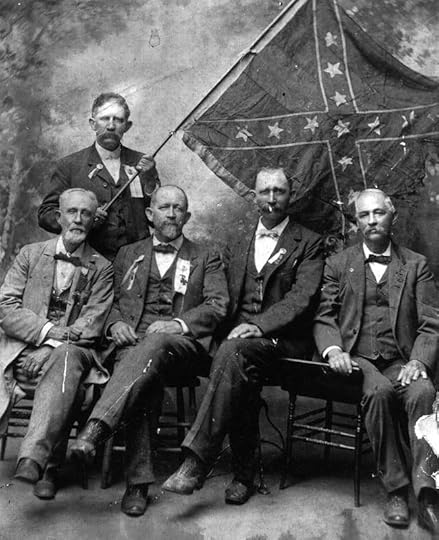 Post-war photo (exact date unknown but probably at either the Dallas or New Orleans reunion). The Bynum brothers of Company A with the colors carried by the 2nd Mississippi at Hatcher's Run on April 2, 1865. From left to right, seated are William, George W., Turner, and Mark. Standing with the flag is Nathaniel. Not shown is a sixth brother, Joseph. (Photo courtesy of the great-grandson of William Bynum, John E. Dear). Bynum, George W.
Post-war photo (exact date unknown but probably at either the Dallas or New Orleans reunion). The Bynum brothers of Company A with the colors carried by the 2nd Mississippi at Hatcher's Run on April 2, 1865. From left to right, seated are William, George W., Turner, and Mark. Standing with the flag is Nathaniel. Not shown is a sixth brother, Joseph. (Photo courtesy of the great-grandson of William Bynum, John E. Dear). Bynum, George W.
Company: A
Initial Rank: Private
Final Rank: 2nd Sergeant
Joined: Wednesday, May 1, 1861
Term (yrs): 1
Occupation: Student
Age: 21
Enrolled at: Tishomingo Co., MS
Enrolled By: Capt. Leeth
Promoted: Yes
Roll of Honor: No
Born: North Carolina
Marital Status: Single
Residence Rienzi, MS
Service Summary: Also see Ham's Regiment of Mississippi Cavalry and the 11th Consolidated Mississippi Cavalry. Promoted to 4th Corporal on 4/22/1862. Apparently captured near Shepherdstown, VA and paroled on 9/25/1862. Promoted to 3rd Corporal on 10/16/1862. Promoted to 2nd Sergeant on 7/1/1863. Listed as AWOL since 2/1/1864 and deserted. Appointed Adjutant in Harris' Battalion of Cavalry (Miss State Troops) while on furlough without a regular transfer or discharge from his company.
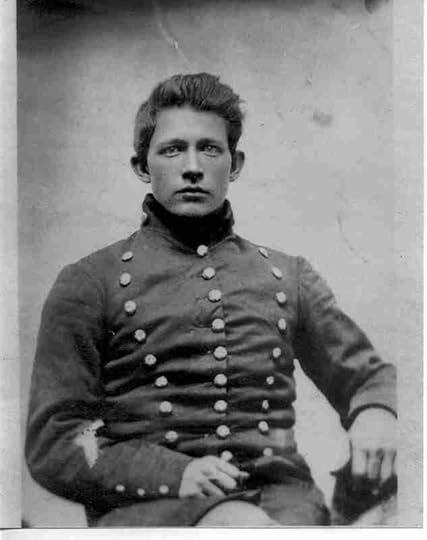 Private George W. Bynum, Company A 2nd Mississippi Infantry
Private George W. Bynum, Company A 2nd Mississippi Infantry
Bynum, Joseph N.
Company: A
Initial Rank: Private
Final Rank: Private
Joined: Saturday, September 21, 1861
Term (yrs): 1
Occupation: Student
Age: 19
Enrolled at: Rienzi, MS
Enrolled By: Lt. Davenport
Promoted: No
Roll of Honor: No
Born: North Carolina
Marital Status: Single
Residence Rienzi, MS
Service Summary: Wounded on 6/27/1862 at battle of Gaines Mill. Discharged on 4/3/1863 on surgeons certificate of disability due to wounds received at Gaines Mill.
Bynum, Marcus W.
Company: A
Initial Rank: Private
Final Rank: Private
Joined: Monday, September 30, 1861
Term (yrs): 1
Occupation: Physician
Age: 25
Enrolled at: Iuka, MS
Enrolled By: Lt. Davenport
Promoted: No
Roll of Honor: No
Born: North Carolina
Marital Status: Married
Residence: Rienzi, MS
Service Summary: Discharged on 7/17/1862 -- substitute provided.
Bynum, Nathaniel M.
Company: A
Initial Rank: Private
Final Rank: Private
Joined: Saturday, March 1, 1862
Term (yrs): 3
Occupation: Student
Age: 17
Enrolled at: Jacinto, MS
Enrolled By: Lt. Clayton
Promoted: No
Roll of Honor: No
Born: North Carolina
Marital Status: Single
Residence: Rienzi, MS
Service Summary: Captured at Petersburg (Hatcher's Run) on 4/2/1865. Released from Fort Delaware on oath on 6/11/1865.
Bynum, Turner
Company: A
Initial Rank: 1st Corporal
Final Rank: First Sergeant
Joined: Wednesday, May 1, 1861
Term (yrs): 1
Occupation: Clerk
Age: 19
Enrolled at: Tishomingo Co., MS
Enrolled By: Capt. Leeth
Promoted: Yes
Roll of Honor: No
Born: North Carolina
Marital Status: Single
Residence: Rienzi, MS
Service Summary: Promoted to 5th Sergeant circa Nov/Dec, 1861. Promoted to 3rd Sergeant about Mar/Apr, 1862. Promoted to 2nd Sergeant about May/Jun, 1862. Wounded at Gaines Mill on 6/27/1862. Promoted to 1st Sergeant in Sep/Oct, 1864 time period (while a POW). Captured at Gettysburg on 7/3/1863. Taken to Fort Delaware. Released on oath on 6/11/1865.
Bynum, William L. D.
Company: A
Initial Rank: Private
Final Rank: Private
Joined: Saturday, September 21, 1861
Term (yrs): 1
Occupation: Farmer
Age: 27
Enrolled at: Rienzi, MS
Enrolled By: Lt. Davenport
Promoted: No
Roll of Honor: No
Born: North Carolina
Marital Status: Married
Residence Rienzi, MS
Service Summary: Note on CMSR jacket says to also see 7th Miss Cavalry Regiment (Partisan Rangers). Wounded on 6/27/1862 at battle of Gaines Mill. Transferred to 7th Mississippi Cavalry Regiment (elected 2nd Lt.) on 11/5/1862.
 Post-war photo (exact date unknown but probably at either the Dallas or New Orleans reunion). The Bynum brothers of Company A with the colors carried by the 2nd Mississippi at Hatcher's Run on April 2, 1865. From left to right, seated are William, George W., Turner, and Mark. Standing with the flag is Nathaniel. Not shown is a sixth brother, Joseph. (Photo courtesy of the great-grandson of William Bynum, John E. Dear). Bynum, George W.
Post-war photo (exact date unknown but probably at either the Dallas or New Orleans reunion). The Bynum brothers of Company A with the colors carried by the 2nd Mississippi at Hatcher's Run on April 2, 1865. From left to right, seated are William, George W., Turner, and Mark. Standing with the flag is Nathaniel. Not shown is a sixth brother, Joseph. (Photo courtesy of the great-grandson of William Bynum, John E. Dear). Bynum, George W. Company: A
Initial Rank: Private
Final Rank: 2nd Sergeant
Joined: Wednesday, May 1, 1861
Term (yrs): 1
Occupation: Student
Age: 21
Enrolled at: Tishomingo Co., MS
Enrolled By: Capt. Leeth
Promoted: Yes
Roll of Honor: No
Born: North Carolina
Marital Status: Single
Residence Rienzi, MS
Service Summary: Also see Ham's Regiment of Mississippi Cavalry and the 11th Consolidated Mississippi Cavalry. Promoted to 4th Corporal on 4/22/1862. Apparently captured near Shepherdstown, VA and paroled on 9/25/1862. Promoted to 3rd Corporal on 10/16/1862. Promoted to 2nd Sergeant on 7/1/1863. Listed as AWOL since 2/1/1864 and deserted. Appointed Adjutant in Harris' Battalion of Cavalry (Miss State Troops) while on furlough without a regular transfer or discharge from his company.
 Private George W. Bynum, Company A 2nd Mississippi Infantry
Private George W. Bynum, Company A 2nd Mississippi Infantry Bynum, Joseph N.
Company: A
Initial Rank: Private
Final Rank: Private
Joined: Saturday, September 21, 1861
Term (yrs): 1
Occupation: Student
Age: 19
Enrolled at: Rienzi, MS
Enrolled By: Lt. Davenport
Promoted: No
Roll of Honor: No
Born: North Carolina
Marital Status: Single
Residence Rienzi, MS
Service Summary: Wounded on 6/27/1862 at battle of Gaines Mill. Discharged on 4/3/1863 on surgeons certificate of disability due to wounds received at Gaines Mill.
Bynum, Marcus W.
Company: A
Initial Rank: Private
Final Rank: Private
Joined: Monday, September 30, 1861
Term (yrs): 1
Occupation: Physician
Age: 25
Enrolled at: Iuka, MS
Enrolled By: Lt. Davenport
Promoted: No
Roll of Honor: No
Born: North Carolina
Marital Status: Married
Residence: Rienzi, MS
Service Summary: Discharged on 7/17/1862 -- substitute provided.
Bynum, Nathaniel M.
Company: A
Initial Rank: Private
Final Rank: Private
Joined: Saturday, March 1, 1862
Term (yrs): 3
Occupation: Student
Age: 17
Enrolled at: Jacinto, MS
Enrolled By: Lt. Clayton
Promoted: No
Roll of Honor: No
Born: North Carolina
Marital Status: Single
Residence: Rienzi, MS
Service Summary: Captured at Petersburg (Hatcher's Run) on 4/2/1865. Released from Fort Delaware on oath on 6/11/1865.
Bynum, Turner
Company: A
Initial Rank: 1st Corporal
Final Rank: First Sergeant
Joined: Wednesday, May 1, 1861
Term (yrs): 1
Occupation: Clerk
Age: 19
Enrolled at: Tishomingo Co., MS
Enrolled By: Capt. Leeth
Promoted: Yes
Roll of Honor: No
Born: North Carolina
Marital Status: Single
Residence: Rienzi, MS
Service Summary: Promoted to 5th Sergeant circa Nov/Dec, 1861. Promoted to 3rd Sergeant about Mar/Apr, 1862. Promoted to 2nd Sergeant about May/Jun, 1862. Wounded at Gaines Mill on 6/27/1862. Promoted to 1st Sergeant in Sep/Oct, 1864 time period (while a POW). Captured at Gettysburg on 7/3/1863. Taken to Fort Delaware. Released on oath on 6/11/1865.
Bynum, William L. D.
Company: A
Initial Rank: Private
Final Rank: Private
Joined: Saturday, September 21, 1861
Term (yrs): 1
Occupation: Farmer
Age: 27
Enrolled at: Rienzi, MS
Enrolled By: Lt. Davenport
Promoted: No
Roll of Honor: No
Born: North Carolina
Marital Status: Married
Residence Rienzi, MS
Service Summary: Note on CMSR jacket says to also see 7th Miss Cavalry Regiment (Partisan Rangers). Wounded on 6/27/1862 at battle of Gaines Mill. Transferred to 7th Mississippi Cavalry Regiment (elected 2nd Lt.) on 11/5/1862.
Published on January 19, 2020 05:37
January 12, 2020
Soldier Spotlight: Private Daniel Dodd, Company G
A Sketch of the History of the Second Mississippi Infantry Regiment: Private Daniel Dodd, Company G, the Pontotoc Minute Men 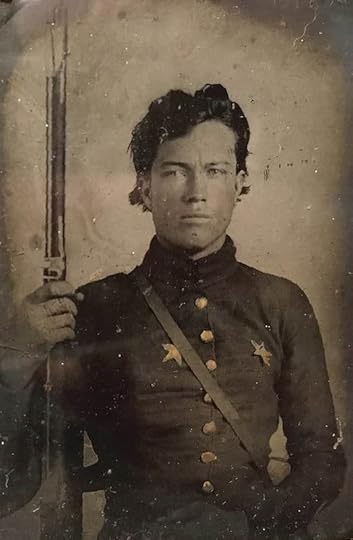 I will be using some of my upcoming posts to include a photo and a short bio of a member of the regiment. I don't have many, especially wartime photos of members in uniform, but I have collected a few over the years. Who knows, one of the folks may just be a distant relative of one of my blog visitors. This is a photo of Daniel Dodd, Company G (Pontotoc Minute Men) of Pontotoc County:
I will be using some of my upcoming posts to include a photo and a short bio of a member of the regiment. I don't have many, especially wartime photos of members in uniform, but I have collected a few over the years. Who knows, one of the folks may just be a distant relative of one of my blog visitors. This is a photo of Daniel Dodd, Company G (Pontotoc Minute Men) of Pontotoc County:
Private Dodd enlisted on Monday, May 1, 1861 from Pontotoc County. He was enrolled by Captain Miller. He was 21 years of age, single, a farmer by occupation. He was killed in battle at 2nd Manassas on August 29, 1862.
Oh, I should add his physical description from his Compiled Military Service Record (CMSR) also. He was six feet tall, dark complexion, hazel eyes, and dark hair.
I always found something haunting about his photo. A young life, so full of potential, snuffed out, like so many others during our Civil War.
 I will be using some of my upcoming posts to include a photo and a short bio of a member of the regiment. I don't have many, especially wartime photos of members in uniform, but I have collected a few over the years. Who knows, one of the folks may just be a distant relative of one of my blog visitors. This is a photo of Daniel Dodd, Company G (Pontotoc Minute Men) of Pontotoc County:
I will be using some of my upcoming posts to include a photo and a short bio of a member of the regiment. I don't have many, especially wartime photos of members in uniform, but I have collected a few over the years. Who knows, one of the folks may just be a distant relative of one of my blog visitors. This is a photo of Daniel Dodd, Company G (Pontotoc Minute Men) of Pontotoc County:Private Dodd enlisted on Monday, May 1, 1861 from Pontotoc County. He was enrolled by Captain Miller. He was 21 years of age, single, a farmer by occupation. He was killed in battle at 2nd Manassas on August 29, 1862.
Oh, I should add his physical description from his Compiled Military Service Record (CMSR) also. He was six feet tall, dark complexion, hazel eyes, and dark hair.
I always found something haunting about his photo. A young life, so full of potential, snuffed out, like so many others during our Civil War.
Published on January 12, 2020 06:32
January 11, 2020
Members of Company B, the O'Connor Rifles
A Sketch of the History of the Second Mississippi Infantry Regiment: Members of Company B, the O'Connor Rifles
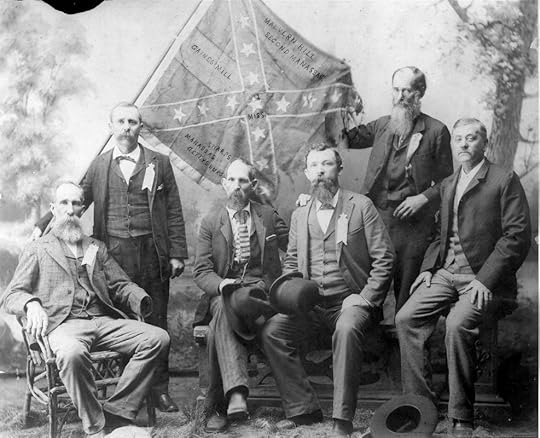 Members of Company B, the O'Connor Rifles of Tippah County, pictured with the 2nd Mississippi colors carried at Hatcher's Run on April 2, 1865 (note that the battle honors have been inaccurately penned in on the photo). The photo is believed to have been taken either at the New Orleans or Dallas reunion. From left to right pictured are John H. Allen, William H. "Billy" Byrn (the last regimental color bearer), Isaac N. Gray, George P. Holcombe, Alexander Wolf, and Lucas H. Byrn. (Photo courtesy of the Mississippi Department of Archives and History). Allen, John H.
Members of Company B, the O'Connor Rifles of Tippah County, pictured with the 2nd Mississippi colors carried at Hatcher's Run on April 2, 1865 (note that the battle honors have been inaccurately penned in on the photo). The photo is believed to have been taken either at the New Orleans or Dallas reunion. From left to right pictured are John H. Allen, William H. "Billy" Byrn (the last regimental color bearer), Isaac N. Gray, George P. Holcombe, Alexander Wolf, and Lucas H. Byrn. (Photo courtesy of the Mississippi Department of Archives and History). Allen, John H.
Company: B
Initial Rank: Private
Final Rank: Private
Joined: Saturday, March 1, 1862
Term (yrs): 3
Occupation: Carpenter
Age 28
Enrolled at: Ripley, MS Enrolled By: Capt. Buchanan
Promoted: No
Roll of Honor: No
Born: North Carolina
Marital Status: Married
Residence: ?
Service Summary: Shot himself in hand on 6/6/1862. Discharged on 7/28/1862 due to gunshot wound to hand resulting in amputation of left arm.
Byrn, William H.
Company: B
Initial Rank: Private
Final Rank: Private
Joined: Wednesday, April 15, 1863
Term (yrs): 3
Occupation: ?
Age: ?
Enrolled at: Ripley, MS
Enrolled By: Capt. Storey
Promoted: No
Roll of Honor: Yes
Born: ?
Marital Status: ?
Residence: ?
Service Summary: Captured at Petersburg (Hatcher's Run) on 4/2/1865. Sent to Fort Delaware. Released on oath on 6/11/1865.
Gray, Isaac N.
Company: B
Initial Rank: Private
Final Rank: Private
Joined: Wednesday, May 1, 1861
Term (yrs): 1
Occupation: Farmer
Age 23
Enrolled at: Tippah Co., MS
Enrolled By: Capt. Buchanan
Promoted: No
Roll of Honor: No
Born: ?
Marital Status: ?
Residence: ?
Service Summary: Wounded on 8/28/1864. In hospital at Richmond. Furloughed 40-days from 9/23/1864.
Holcombe, George P.
Company: B
Initial Rank: Private
Final Rank: Private
Joined: Monday, March 3, 1862
Term (yrs): 3
Occupation: Student
Age 16
Enrolled at: Ripley, MS
Enrolled By: Capt. Buchanan
Promoted: No
Roll of Honor: No
Born: Mississippi
Marital Status: S
Residence: ?
Service Summary: Wounded at 2nd Manassas on 8/29/1862. Sent to hospital. Returned to duty. Wounded at Gettysburg (date not given) and furloughed for 40-days from 7/22/1863. Captured in Tippah Co., MS by the 7th Kansas Cavalry while on wounded furlough on 9/9/1863. Sent to Alton, IL on 10/3/1863. Transferred to Fort Delaware on 2/29/1864. Exchanged on 12/5/1864. Still on disabled list as of 3/14/1865 at Lauderdale, MS.
Wolf, Alexander D.
Company: B
Initial Rank: Private
Final Rank: Private
Joined: Wednesday, May 1, 1861
Term (yrs): 1
Occupation: Farmer
Age 33
Enrolled at: Tippah Co., MS
Enrolled By: Capt. Buchanan
Promoted: No
Roll of Honor: No
Born: ?
Marital Status: ?
Residence: ?
Service Summary: Wounded (in face) in battle at 1st Manassas on 7/21/1861. Returned to duty on 8/9/1861. Discharged due to disability on 12/4/1862.
Byrn, Lucas H.
Company: B
Initial Rank: Private
Final Rank: Sergeant
Joined: Wednesday, May 1, 1861
Term (yrs): 1
Occupation: Clerk
Age 23
Enrolled at: Tippah Co., MS
Enrolled By: Capt. Buchanan
Promoted: Yes
Roll of Honor: No
Born: ?
Marital Status: ?
Residence: Ripley, MS
Service Summary: Acting Sergeant Major from 9/29/1862. Detail duty as acting Assistant Quartermaster since 12/21/1862. Detailed as ambulance sergeant since 4/25/1864 by medical examining board. AWOL since 2/15/1865. Paroled at Memphis, TN on 5/25/1865.
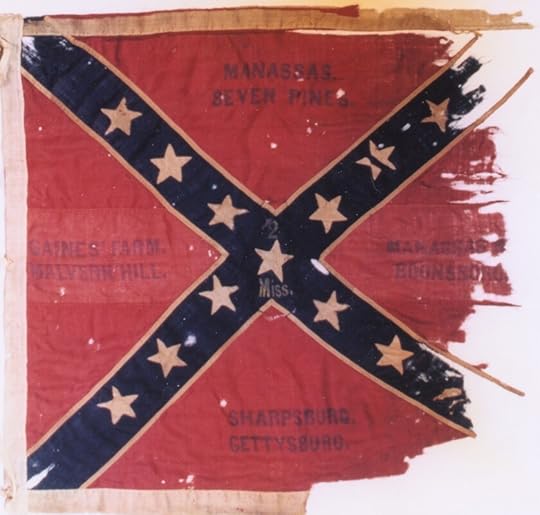 The actual flag shown in the reunion photo above. This is the regimental colors carried by the 2nd Mississippi when they were surrounded and surrendered at Hatcher's Run on April 2, 1865. Billy Byrn was the last color bearer. Before the Federals closed in, Nathaniel Bynum tore the flag from the staff and hid it under his jacket. When they were taken to Fort Delaware as prisoners, at some point the center star and unit designation were cut from the flag and hidden separately from the rest of the flag so in case either piece was found, they would at least have a part of the flag when they were released from prison. When they were released, the center portion was re-sewn into the body of the flag (if you look closely you can see the stitching) and it was used in various reunions before being turned over to the Mississippi State Archives in 1916.
The actual flag shown in the reunion photo above. This is the regimental colors carried by the 2nd Mississippi when they were surrounded and surrendered at Hatcher's Run on April 2, 1865. Billy Byrn was the last color bearer. Before the Federals closed in, Nathaniel Bynum tore the flag from the staff and hid it under his jacket. When they were taken to Fort Delaware as prisoners, at some point the center star and unit designation were cut from the flag and hidden separately from the rest of the flag so in case either piece was found, they would at least have a part of the flag when they were released from prison. When they were released, the center portion was re-sewn into the body of the flag (if you look closely you can see the stitching) and it was used in various reunions before being turned over to the Mississippi State Archives in 1916.
 Members of Company B, the O'Connor Rifles of Tippah County, pictured with the 2nd Mississippi colors carried at Hatcher's Run on April 2, 1865 (note that the battle honors have been inaccurately penned in on the photo). The photo is believed to have been taken either at the New Orleans or Dallas reunion. From left to right pictured are John H. Allen, William H. "Billy" Byrn (the last regimental color bearer), Isaac N. Gray, George P. Holcombe, Alexander Wolf, and Lucas H. Byrn. (Photo courtesy of the Mississippi Department of Archives and History). Allen, John H.
Members of Company B, the O'Connor Rifles of Tippah County, pictured with the 2nd Mississippi colors carried at Hatcher's Run on April 2, 1865 (note that the battle honors have been inaccurately penned in on the photo). The photo is believed to have been taken either at the New Orleans or Dallas reunion. From left to right pictured are John H. Allen, William H. "Billy" Byrn (the last regimental color bearer), Isaac N. Gray, George P. Holcombe, Alexander Wolf, and Lucas H. Byrn. (Photo courtesy of the Mississippi Department of Archives and History). Allen, John H.Company: B
Initial Rank: Private
Final Rank: Private
Joined: Saturday, March 1, 1862
Term (yrs): 3
Occupation: Carpenter
Age 28
Enrolled at: Ripley, MS Enrolled By: Capt. Buchanan
Promoted: No
Roll of Honor: No
Born: North Carolina
Marital Status: Married
Residence: ?
Service Summary: Shot himself in hand on 6/6/1862. Discharged on 7/28/1862 due to gunshot wound to hand resulting in amputation of left arm.
Byrn, William H.
Company: B
Initial Rank: Private
Final Rank: Private
Joined: Wednesday, April 15, 1863
Term (yrs): 3
Occupation: ?
Age: ?
Enrolled at: Ripley, MS
Enrolled By: Capt. Storey
Promoted: No
Roll of Honor: Yes
Born: ?
Marital Status: ?
Residence: ?
Service Summary: Captured at Petersburg (Hatcher's Run) on 4/2/1865. Sent to Fort Delaware. Released on oath on 6/11/1865.
Gray, Isaac N.
Company: B
Initial Rank: Private
Final Rank: Private
Joined: Wednesday, May 1, 1861
Term (yrs): 1
Occupation: Farmer
Age 23
Enrolled at: Tippah Co., MS
Enrolled By: Capt. Buchanan
Promoted: No
Roll of Honor: No
Born: ?
Marital Status: ?
Residence: ?
Service Summary: Wounded on 8/28/1864. In hospital at Richmond. Furloughed 40-days from 9/23/1864.
Holcombe, George P.
Company: B
Initial Rank: Private
Final Rank: Private
Joined: Monday, March 3, 1862
Term (yrs): 3
Occupation: Student
Age 16
Enrolled at: Ripley, MS
Enrolled By: Capt. Buchanan
Promoted: No
Roll of Honor: No
Born: Mississippi
Marital Status: S
Residence: ?
Service Summary: Wounded at 2nd Manassas on 8/29/1862. Sent to hospital. Returned to duty. Wounded at Gettysburg (date not given) and furloughed for 40-days from 7/22/1863. Captured in Tippah Co., MS by the 7th Kansas Cavalry while on wounded furlough on 9/9/1863. Sent to Alton, IL on 10/3/1863. Transferred to Fort Delaware on 2/29/1864. Exchanged on 12/5/1864. Still on disabled list as of 3/14/1865 at Lauderdale, MS.
Wolf, Alexander D.
Company: B
Initial Rank: Private
Final Rank: Private
Joined: Wednesday, May 1, 1861
Term (yrs): 1
Occupation: Farmer
Age 33
Enrolled at: Tippah Co., MS
Enrolled By: Capt. Buchanan
Promoted: No
Roll of Honor: No
Born: ?
Marital Status: ?
Residence: ?
Service Summary: Wounded (in face) in battle at 1st Manassas on 7/21/1861. Returned to duty on 8/9/1861. Discharged due to disability on 12/4/1862.
Byrn, Lucas H.
Company: B
Initial Rank: Private
Final Rank: Sergeant
Joined: Wednesday, May 1, 1861
Term (yrs): 1
Occupation: Clerk
Age 23
Enrolled at: Tippah Co., MS
Enrolled By: Capt. Buchanan
Promoted: Yes
Roll of Honor: No
Born: ?
Marital Status: ?
Residence: Ripley, MS
Service Summary: Acting Sergeant Major from 9/29/1862. Detail duty as acting Assistant Quartermaster since 12/21/1862. Detailed as ambulance sergeant since 4/25/1864 by medical examining board. AWOL since 2/15/1865. Paroled at Memphis, TN on 5/25/1865.
 The actual flag shown in the reunion photo above. This is the regimental colors carried by the 2nd Mississippi when they were surrounded and surrendered at Hatcher's Run on April 2, 1865. Billy Byrn was the last color bearer. Before the Federals closed in, Nathaniel Bynum tore the flag from the staff and hid it under his jacket. When they were taken to Fort Delaware as prisoners, at some point the center star and unit designation were cut from the flag and hidden separately from the rest of the flag so in case either piece was found, they would at least have a part of the flag when they were released from prison. When they were released, the center portion was re-sewn into the body of the flag (if you look closely you can see the stitching) and it was used in various reunions before being turned over to the Mississippi State Archives in 1916.
The actual flag shown in the reunion photo above. This is the regimental colors carried by the 2nd Mississippi when they were surrounded and surrendered at Hatcher's Run on April 2, 1865. Billy Byrn was the last color bearer. Before the Federals closed in, Nathaniel Bynum tore the flag from the staff and hid it under his jacket. When they were taken to Fort Delaware as prisoners, at some point the center star and unit designation were cut from the flag and hidden separately from the rest of the flag so in case either piece was found, they would at least have a part of the flag when they were released from prison. When they were released, the center portion was re-sewn into the body of the flag (if you look closely you can see the stitching) and it was used in various reunions before being turned over to the Mississippi State Archives in 1916.
Published on January 11, 2020 15:17
December 22, 2019
Ornamental Powder Horn from Camp Fisher, VA
A Sketch of the History of the Second Mississippi Infantry Regiment:
Private James C. Knight at Camp Fisher, Virginia Unfortunately, this beautiful piece of art is in a private collection. But I did manage to obtain photographs of this unusual carved ornamental powder horn that belonged to Private James C. Knight, Company I, Cherry Creek Rifles (Pontotoc County), 2nd Mississippi Infantry Regiment.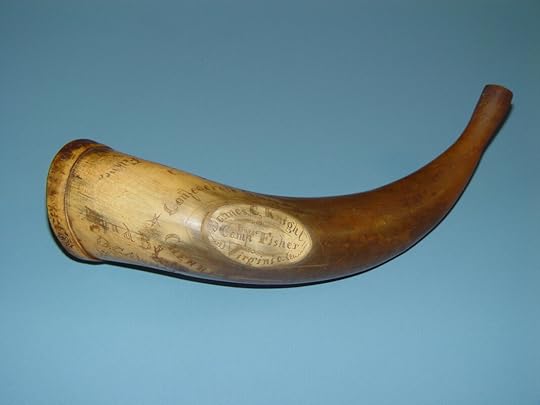
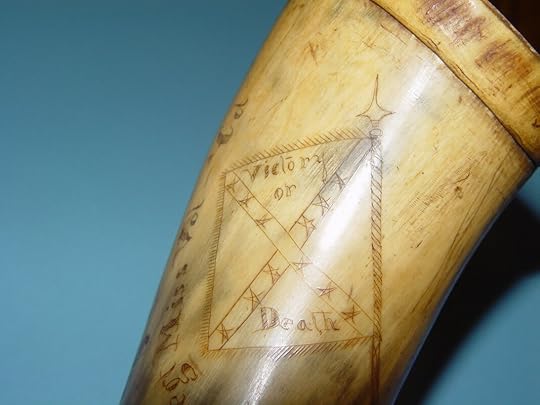
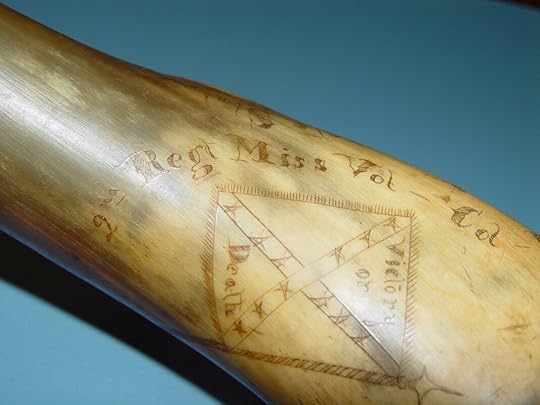
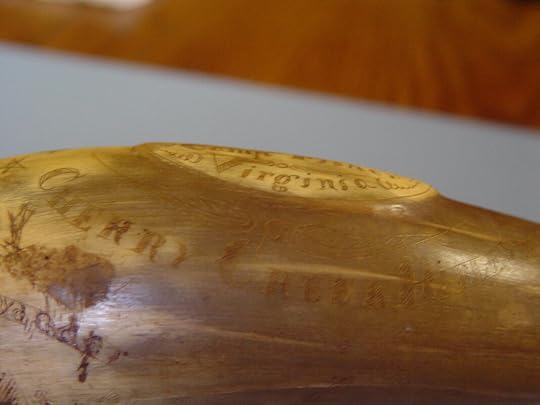
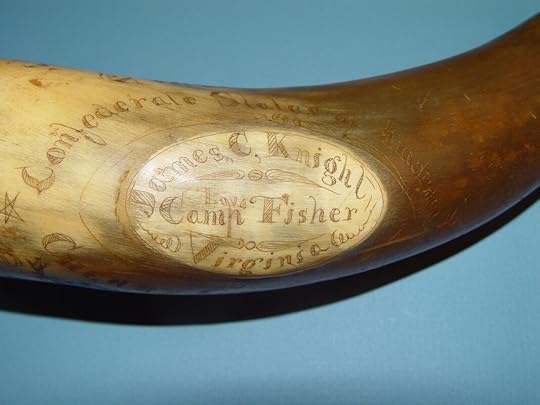 Private James C. Knight was 20 years old when he enlisted on Wednesday, May 1, 1861. He was enrolled in Pontotoc County by Captain Herring in Company I, Cherry Creek Rifles. His occupation was listed as "farmer." He was wounded at Sharpsburg on 9/17/1862. Furloughed. Returned to duty. Captured at Gettysburg on 7/3/1863. Died at Fort Delaware on 4/17/1865 of pneumonia. Locality of grave: "Jersey Shore."
Private James C. Knight was 20 years old when he enlisted on Wednesday, May 1, 1861. He was enrolled in Pontotoc County by Captain Herring in Company I, Cherry Creek Rifles. His occupation was listed as "farmer." He was wounded at Sharpsburg on 9/17/1862. Furloughed. Returned to duty. Captured at Gettysburg on 7/3/1863. Died at Fort Delaware on 4/17/1865 of pneumonia. Locality of grave: "Jersey Shore."
Private James C. Knight at Camp Fisher, Virginia Unfortunately, this beautiful piece of art is in a private collection. But I did manage to obtain photographs of this unusual carved ornamental powder horn that belonged to Private James C. Knight, Company I, Cherry Creek Rifles (Pontotoc County), 2nd Mississippi Infantry Regiment.




 Private James C. Knight was 20 years old when he enlisted on Wednesday, May 1, 1861. He was enrolled in Pontotoc County by Captain Herring in Company I, Cherry Creek Rifles. His occupation was listed as "farmer." He was wounded at Sharpsburg on 9/17/1862. Furloughed. Returned to duty. Captured at Gettysburg on 7/3/1863. Died at Fort Delaware on 4/17/1865 of pneumonia. Locality of grave: "Jersey Shore."
Private James C. Knight was 20 years old when he enlisted on Wednesday, May 1, 1861. He was enrolled in Pontotoc County by Captain Herring in Company I, Cherry Creek Rifles. His occupation was listed as "farmer." He was wounded at Sharpsburg on 9/17/1862. Furloughed. Returned to duty. Captured at Gettysburg on 7/3/1863. Died at Fort Delaware on 4/17/1865 of pneumonia. Locality of grave: "Jersey Shore."
Published on December 22, 2019 09:11



